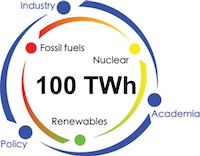Calculating the cost of electricity, most of the time in $/KWh, is necessary but complex.
Many different methods of calculation can be used but they are always incomplete. We have studied 4 of them: LCOE, VALCOE, LFSCOE and the cost of electricity when limiting the emissions to 50 gCO2 per KWh.
We used 4 principal studies: The LCOE+ of the LAZARD bank; The VALCOE of the IEA; The LFSCOE of the Bank of America and the [50g/KWh for 2050] modelling of the NEA.
LCOE (Levelized Cost of Electricity) and its limits.
The LAZARD bank evaluates the cost of electricity by the Levelized cost of electricity (LCOE), which gives the cost of the produced electricity at the exit of the plant. It is the most used method due to its relative simplicity. The LAZARD study is much referenced by environmentalists, but it is not the only one, as the IEA also uses this approach. Their resulting costs are quite different, because they make other assumptions…
Even if the LAZARD experts consider that storage costs have to be added to the costs of Variable Renewable Energy (VRE), the LCOE is a limited method which doesn’t consider the additional costs needed to deliver the produced electricity to the customers, like the cost of intermittency.
VALCOE (Value Adjusted LCOE), more precise but still limited.
To calculate to VALCOE, the IEA takes 3 different values into account: the energy value (market value of the produced electricity of a technology), the capacity value (ability of a technology to reliably meet demand, contributing to the adequacy of the system) and the flexibility value (non-energy ancillary services needed in power systems).
This leads to slightly more realistic costs but still doesn’t consider enough global system costs and external costs to deliver the produced electricity to the customers.
LFSCOE (Levelized Full System Cost of Electricity) and its differences.
The Bank of America calculates the cost of electricity by using the LFSCOE method. This differs from the other methodologies as it calculates the cost of electricity in the (hypothetical) case that one single energy source delivers 100% of the electrical needs. By doing this, the BoA ends up by having the cost of energy as it is delivered instead of produced.
The cost of renewables is vastly superior even if the BoA reduces the scope to delivering only 95% of the needs. The effects of other percentages of the production delivered by one single source have not yet been calculated by the BoA. This was the specific purpose of the NEA modelling.
Modelling of the system cost for low-carbon electricity in 2050.
The OECD-NEA has issued a study of the total system costs cost of electricity in 2050, based on real weather data for a full year and the constraint that the whole production system could only emit 50g of CO2 per kWh.
This study concludes that going beyond around 30% of VRE is economically inefficient for a country in Europe such as France, even if the costs of renewables are assumed to be the lowest.
Conclusion.
Every cost calculation method has its pro’s and con’s and assuming that one method can understand and reflect everything is a wrong assumption. VRE may be low-cost in generating electricity, but they truly appear to be more expensive than any other technology when it comes to deliver dispatchable electricity to the customers.
We also learned, based on an extrapolation of the 4th study by the MIT, that the costs increase exponentially when going deeper in reducing carbon emissions and increasing VRE penetration, leading to the conclusion that reducing nuclear under 50% is economically inefficient, if decarbonisation remains a priority.




